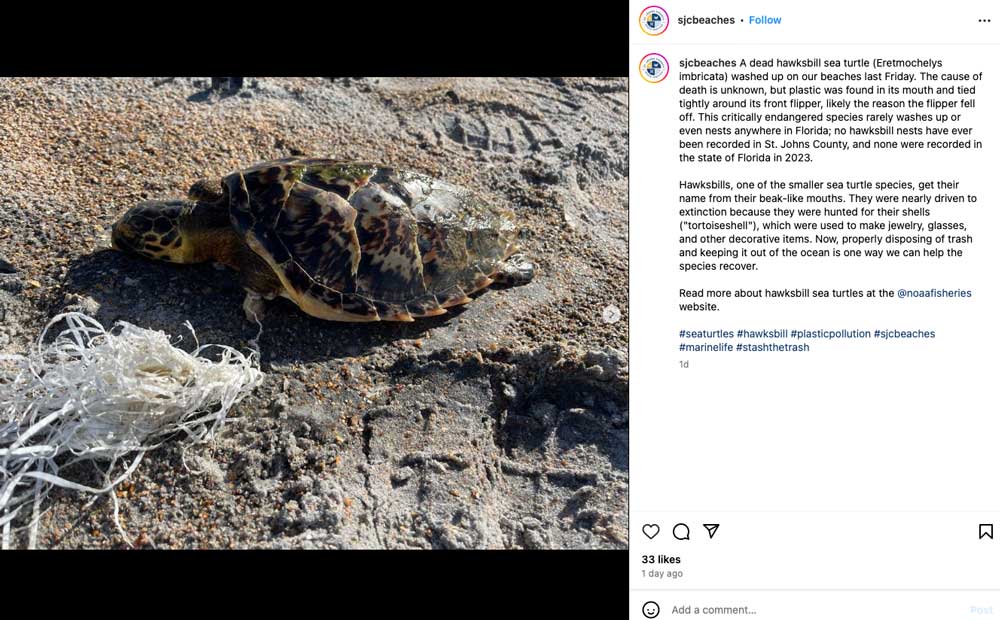While the cause of death has not been revealed, officials with St. Johns County believe that the turtle, which is not known to nest in the state, died from the plastic as some was found in its mouth.
A hawksbill sea turtle (Eretmochelys imbricata) washed up dead on St. Johns County Beach in Florida entangled in plastic. While the cause of death has not been revealed, officials with St. Johns County believe that the turtle, which is not known to nest in the state, died from the plastic as some was found in its mouth and the remaining plastic was wrapped tightly around its front flipper area, which was missing from the turtle. The county’s beach services division posted a photo of the dead turtle to its Instagram page.
“The devastating outcome for this hawksbill sea turtle serves as a grim reminder of the harmful impacts of plastic pollution on ocean wildlife. We are living in a single-use plastic society where we can’t escape plastic, and neither can marine animals,” Christy Leavitt of Oceana said in a statement mailed to ReptilesMagazine.com.
“Tragedies in the ocean often go unobserved, and the ones that involve plastic are no different. We need government policies to ensure companies reduce their production of single-use plastics to combat the plastics crisis and prevent the senseless suffering of marine life.”
With the amount of plastic generated worldwide, it is a non-surprise that millions of tons of these non-biodegradable man made materials are found in the world’s waterways and oceans.
View this post on Instagram
A 2018 study found that micro plastics and what is now called marine plastics have been found in all seven marine turtle species. That study looked at both stranded and bycaught marine reptiles in both the Atlantic and Pacific Ocean as well as the Mediterranean Sea and found marine plastics in the digestive systems off all seven species: green (Chelonia mydas), loggerhead (Caretta caretta), Kemp’s ridley (Lepidochelys kempii), leatherback (Dermochelys coriacea), flatback (Natator depressus), hawksbill (Eretmochelys imbricata) and olive ridley turtles (Lepidochelys olivacea).
A 2021 study looked at dead juvenile sea turtles from Queensland, Australia, Western Australia and the Indian Ocean that were collected and frozen. The study looked at the entire gastrointestinal tracts and bladders of 121 juveniles of five species, (green, loggerhead, fallback, hawksbill and olive Ridley).
The researchers divided the ingested plastics into sub-categories, including plastic pellets or nurdles, sheetlike plastic scub as plastic bags, threadlike/filamentous plastic such as remains of rope, foamed plastics such as polystyrene, fragmentssuch as hard plastic pieces and others such as rubber, elastics, and items that are ‘plastic-like’ but don’t fit into a specific category. The plastics were also divided into colors.
What the researchers found was of all the species, the green sea turtle juveniles (Chelonia mydas) ingested the most plastic, with one individual from the Pacific Ocean having 144 pieces in its GI tract and one individual from the Indian Ocean found with 343 pieces of plastic. None of the seven hawksbill (Eretmochelys imbricata) juveniles from either ocean had any plastics present in their GI tracts. And no turtles had plastics in their bladders.
Of the plastics ingested in the Pacific Ocean, the highest numbers were clear in coloration, followed by white. The Indian Ocean’s most abundant colored plastic ingested was green and blue. The majority of the plastics ingested were smaller than 5mm in length, 78 percent in the Pacific Ocean and 95 percent in the Indian Ocean.
The study highlights the high incidence of plastic ingestion in post hatchling marine turtles, with filamentous pieces made of polyethylene, polypropylene and nylon that were green and blue in color were the most abundant ingested plastic in the Indian Ocean, with the key component of this plastic discarded fishing gear, called ghost gear.
And then there’s the infamous sea turtle video with a straw up its nostril.
Video: Researchers Remove Plastic Drinking Straw From Sea Turtle’s Nostril
Until manufacturers of plastics and the people who purchase products encased in plastics rethink how these materials are affecting wildlife, not much will be accomplished in terms of reducing the use of plastics around the world.
Hawksbill Turtle Information
The hawksbill sea turtle (Eretmochelys imbricata) family, Cheloniidae can be found in tropical and subtropical regions of the Atlantic, Pacific, and Indian Oceans. It weighs around 95 to 165 pounds, and averages about 2 1/2 feet in length. It is said to reach maturity at 30 years, and live from 30 to 50 years. It nests about four to five times each season and deposits around 140-150 eggs per clutch, every 14 days. The turtle has been listed as an Endangered Species since 1970.



